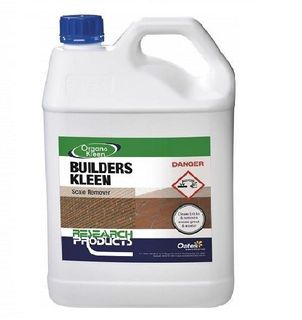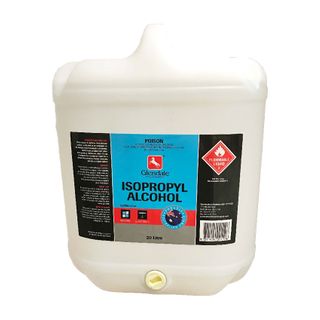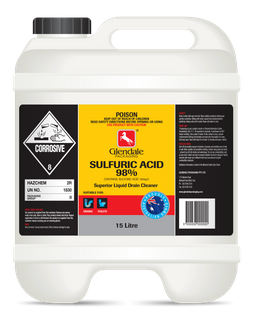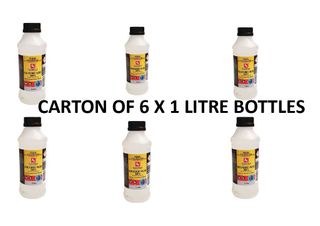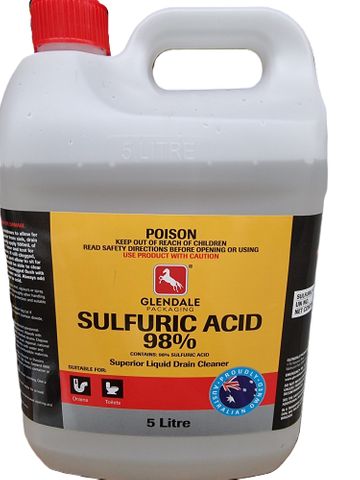
Sulfuric Acid 98% 5 Litre
Description
SULFURIC ACID 98% 5LT / SULPHURIC ACID 98% 5LT - also available in 15litre drums and 1 litre bottles, and 6x1 litre bottle packs. They are heavy to ship and are classified as dangerous goods both of which affect shipping costs.
Sulphuric acid is used in acidic drain cleaners to unclog blocked pipes, etch metal surfaces. , and even refill acid batteries under appropriate circumstances. They can be used to unblock toilet pipes. They can dissolve grease, bacteria buildup, and toilet paper. In both cases, special care is needed to manage the build-up of fumes that are capable of generating gases that if not released could cause pipes to explode. Metal surfaces react to acids depending on their type and alloy content.
The PH is a minimum 1 on the PH scale of 1 (highly acidic) -12 (highly alkaline).
Domestic drain cleaners
Used in the manufacture of various grades of battery acids
Used in the manufacture of speciality chemicals for the metal finishing industry
Key Substance in the chemical industry
Fertilizer manufacture
Mineral processing
Oil refining
Wastewater Processing
Chemical synthesis
If you are confused about where to buy sulfuric acid, Rapid Clean stocks the 1-litre bottle and 15-litre drum. It is available on special order in 15litres, 5 litres, and 200 litres. Buying a pack of 6 x 1litre bottles is economical.
WARNING- This substance may be harmful if misused, mishandled or used inappropriately - ENSURE ALL INSTRUCTIONS ARE FOLLOWED AND PPE IS WORN. SAFETY DATA SHEET BELOW.
Suitable for Drains & Toilets
Use product with caution
Read safety directions and follow prior to opening
Always wear correct PPE, such as some nitrile gloves, safety glasses, face shields, rubber boots, overalls and possible respirator as necessary
Be aware of exposure limits published by Safe Work Australia Sulfuric Acid 7664-93-9 covering exposure of eight-hour periods, and over 15-minute periods.
Corrosive class 8

UN NO. 1830
Safety Data Sheet
Also available in:
How to Use Sulfuric Acid for Drain Cleaning
Acids are an aggressive class of clog-eating chemicals, and the best acids for cleaning plumbing pipes include hydrochloric acid and sulfuric acid. Acidic drain cleaners should be a last resort and only used when other drain cleaning chemicals don't work fast enough or can't do the job. They're hazardous and not particularly good for the pipes or the environment, and some countries, such as the UK, prohibit their use by anyone other than licensed professionals.
you can buy sulfuric acid drain cleaner that is 98 percent sulfuric acid solutions, which means they're highly concentrated, so you must treat them with respect. Follow the directions on the product label carefully and observe the standard safety precautions for handling an acid.
Safety Guidelines for Using a Sulfuric Acid Drain Cleaner
Never pour water into an acid. If you have to dilute the acid, pour it into the water — never the other way around. The reason is that the hydration reaction of sulfuric acid is highly exothermic, which means it releases heat, and the mixture can boil spontaneously. Acid is denser than water, so it sinks, and the explosive bubbles spray the acid solution in all directions.
There's a potential for spitting and spraying even when you pour acid into water, so when you use a sulfuric acid drain cleaner, you need to wear protective eyewear and cover your hands and other parts of your body. Clear the area around the sink and cover the tap before using the drain cleaner because the corrosive mixture can damage any metal with which it comes in contact.
Because it corrodes metal, sulfuric acid can damage chrome, stainless steel and galvanized steel plumbing pipes. It's recommended for use only if you have plastic plumbing pipes, and even these can sustain heat damage if you introduce the drain cleaner too quickly or use too much of it. Pour the product slowly down the drain, using only the amount recommended on the label.
When to Choose a Sulfuric Acid Drain Cleaner
Sulfuric acid will eat through a number of drain-clogging materials that other drain cleaners, including those that contain sodium hydroxide, won't. These materials include paper, grease and hair, which are the main ingredients in many drain clogs. If your pipes are draining slowly, it's safer to use an enzymatic cleaner and let the situation slowly improve, but if the pipes are completely blocked and you can't use the sink, sulfuric acid can provide instant relief.
If you have a plunger, you may be able to clear the clog without using chemicals at all, which is the safest of all options. However, if you plan to plunge, do it before you use sulfuric acid and never after. Remember that the drain cleaner produces heat, and sloshing the hot mixture around in the pipes is a recipe for disaster as far as the pipes are concerned.
Sulfuric acid, like caustic cleaning agents such as sodium hydroxide, isn't safe for septic systems. It kills beneficial bacteria in the tank and reduces the system's ability to digest waste. Use sulfuric acid only if your house is connected to a municipal sewer system.
How to Use Sulfuric Acid to Clean a Drain
The time to use sulfuric acid is when all efforts to mechanically clear the drain, including plunging and snaking, have failed. Don't use sulfuric acid if you've recently introduced another drain-cleaning chemical because the chemicals could combine to create toxic fumes. After putting on protective clothing, covering vulnerable parts of the sink and drain and reading the application instructions on the product label, use the following procedure:
- Open windows to provide ventilation.
- Pour the recommended amount of drain cleaner about 200 ml slowly into the drain.
- Wait for about 10 seconds, then turn on the tap and allow water to flow slowly into the drain. If the drain backs up, turn off the water and wait a bit longer.
- Pour more acid into the drain — up to 500 ml — if the clog doesn't clear. Wait even longer – several minutes to an hour — to give the acid time to work.
- Flush the drain with plenty of water when the clog clears and the drain begins to flow.
- Neutralize the acid by mixing a solution of 1/4 cup baking soda per litre of water and pouring it down the drain. You can use this solution to neutralize any spills that occur.
Using Sulfuric Acid for Toilet Clogs
The safest, easiest and most effective way to clear a toilet clog is to use a plunger. When that doesn't work, you can be sure the clog is massive. Sulfuric acid is strong enough to eat through massive clogs, but it's generally not recommended for toilets, especially if the house is on a septic system. However, there's at least one sulfuric acid drain cleaner that's safe for septic systems.
source: https://www.hunker.com/13421987/how-to-use-sulfuric-acid-for-drain-cleaning


